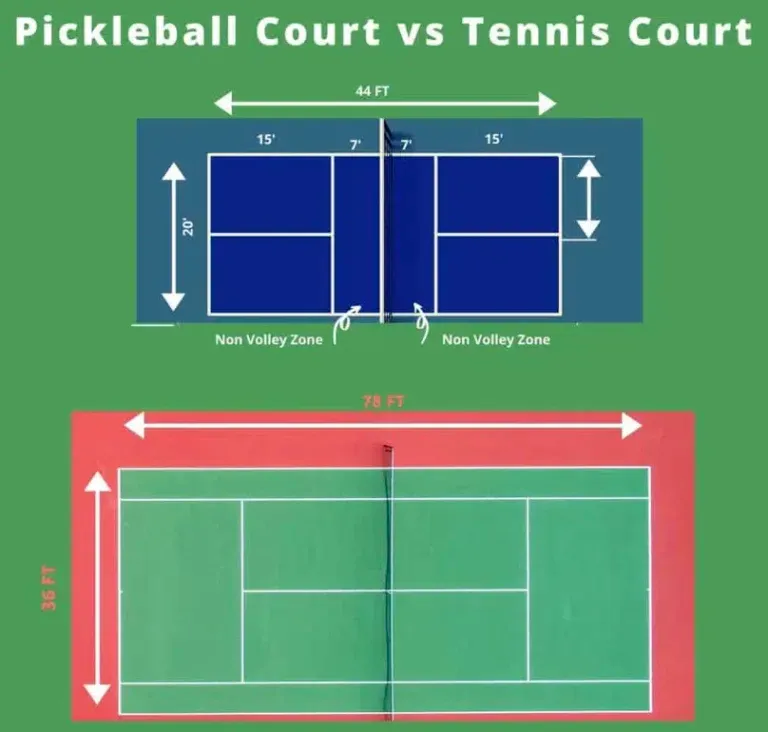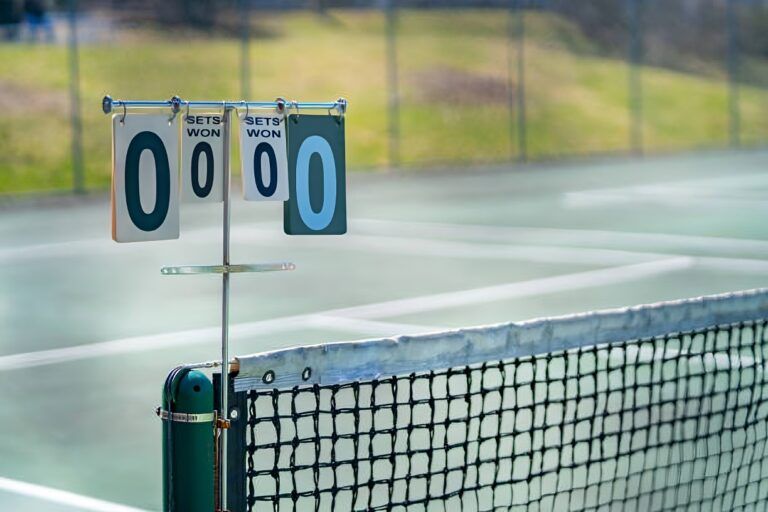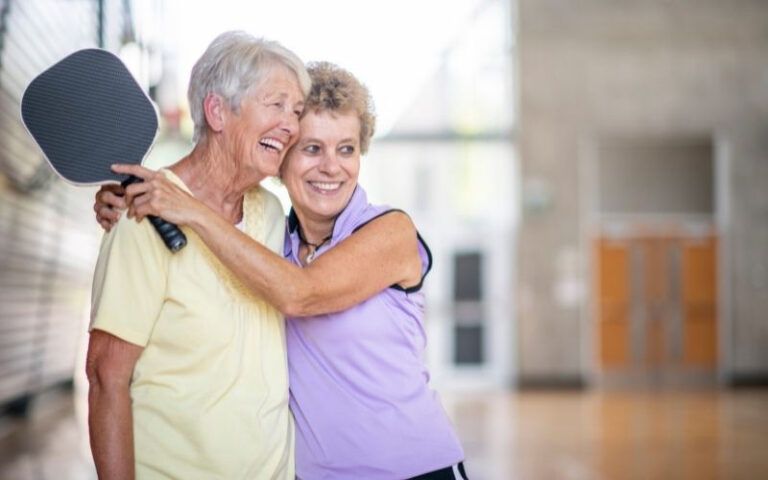Pickleball vs Tennis Court Size and Setup
The court size of each sport is the most apparent difference that influences gameplay and player experience. A standard pickleball court is modestly sized at 20 feet by 44 feet, resembling the dimensions of a doubles badminton court. This compact playing area promotes a more manageable physical endeavor, allowing players to engage socially while partaking in doubles play or singles matches.
Smaller Court Size
The smaller court of pickleball is not just a matter of dimensions; it fundamentally alters the way the game is played. With players positioned closer to one another, exchanges often become quick and rely heavily on strategic placements over raw power. The layout, devoid of specific alleys for doubles, encourages players to seamlessly navigate the court, enhancing the collaborative spirit of doubles matches, which have become a hallmark of pickleball culture.

No Doubles Alleys
In tennis, doubles alleys create additional space that necessitates larger swings and faster reactions, making it more challenging, particularly for beginners. Thus, the absence of this element makes pickleball not only more accommodating for new players, especially older adults or those returning to sports, but also invites a more interactive and sociable environment where players can gather and share in the fun.
Equipment: From Rackets to Paddles
The equipment used in pickleball and tennis diverges significantly, further distinguishing the two sports. In tennis, players wield string rackets that can weigh between 9 to 12 ounces, accompanied by felt-covered rubber balls that are designed for high-speed play and an exhilarating bounce. Conversely, in pickleball, the players’ tools are markedly different.

Paddles vs. Rackets
Pickleball paddles are typically constructed from lighter materials such as wood or composite materials, weighing between 7 to 8 ounces. This significant weight difference results in a unique playing experience where finesse and placement often triumph over sheer power. The paddles’ solid surface and lack of strings contribute to this discretion in shot-making, requiring players to develop new skills distinct from their tennis routines.
Ball Characteristics
Moreover, the balls used in each sport are tailored to their respective environments. Tennis balls, with their rubber cores and quick, high bounces, demand precision in timing and footwork. On the other hand, pickleball features lightweight plastic balls with holes, akin to wiffle balls. This design leads to slower speeds and lower bounces, encouraging players to engage in strategic net play, incorporating dinks and volleys at closer intervals that differ from the longer rallies commonly seen in tennis.

Gameplay Dynamics: Scoring and Serving
Understanding the willows of gameplay dynamics between pickleball and tennis can impart valuable insights to prospective new players. While both sports revolve around winning points by executing skillful shots, the methods by which they score and the pace of play differ broadly.
Understanding Scoring Systems
In pickleball, the unique scoring system allows players to earn points only when they serve, with typical games played to either 11, 15, or 21 points. This feature enhances the intensity of serves, emphasizing careful placement and honest strategy over brute strength. If the serving team makes an error, play switches to the receiving team. All services are underhand, establishing a gentle yet strategic tone to the game.

In contrast, tennis employs a more complex scoring hierarchy. Players are awarded points based on a system of 15, 30, 40, and game points, with no requirement to be serving to score. This complexity increases tension and excitement, allowing each game to build suspense as players edge closer to a set victory.
The Serving Game
When it comes to serving, pickleball’s approach establishes a markedly different energy in gameplay. The emphasis on an underhand serve contrasts with tennis's traditional overhead hits, providing an invitation to engage in tactical play rather than solely relying on powerful strikes.
Accessibility and Appeal
One of the defining characteristics of a sport is its accessibility and the demographics it attracts. Here, the divergence between pickleball vs tennis becomes evident, especially when players of varying skill levels are considered.
Evaluating Accessibility
Often branded as a more accessible sport, pickleball has carved a niche as a great entry-point for beginners, particularly older adults who may find traditional tennis physically demanding. The lower physical demands associated with the shorter court and lighter equipment enable players of all backgrounds to participate and enjoy the game without the intimidation that sometimes accompanies tennis.
Popularity Among Different Age Groups
In recent years, the popularity of pickleball has surged, particularly among seniors, many of whom appreciate its social nature and community engagement. While tennis remains a beloved sport worldwide, it's often associated more with athleticism and physical fitness, attracting players who lean toward high-intensity competition. Pickleball’s welcoming environment allows for a spectrum of ages and skill levels, creating a foundation for diverse engagement and social bonding that unites players.

Transferable Skills: From Tennis to Pickleball
Transitioning from tennis to pickleball is not merely a change of sport but rather an opportunity to transfer existing skills while embracing fresh approaches to the game. For seasoned tennis players, the adaptation can be both rewarding and engaging.
Adapting Tennis Skills
Sharpened skills from tennis such as volleys, groundstrokes, and strategic approaches to play are directly transferable to pickleball. The precision and tactical thinking developed on the tennis court can seamlessly contribute to effective gameplay in pickleball, allowing for a smoother transition for players.
Key Adjustments for Success
While familiar skills have their advantages, adapting to the unique rhythm of pickleball requires key adjustments. Players will find that the experience differs considerably, particularly in using a paddle instead of a racket. The lighter paddle necessitates adjustments in technique, timing, and angles of strikes. Furthermore, the smaller court size demands a new approach to positioning and shot selection, requiring a shift in mentality as players find their rhythm within this compact playing field.
Social Aspects: Building Community Connections
Both sports are renowned for their capacity to foster social connection and build community, yet pickleball often excels in this sphere due to its design and demographic reach.
The Welcoming Atmosphere
The social aspect of pickleball is particularly notable, as it is characterized by an inclusive atmosphere where players are encouraged to engage with one another, enjoy casual games, and participate in doubles matches. This approach cultivates a sense of community, as players find themselves gathering for pick-up games or friendly tournaments fostering friendships that transcend the competition.
Structured vs. Recreational Play
While tennis can indeed be social, it often leans toward formalized competitions and matches, marking it as a sport that may attract a more serious crowd. Pickleball's inherent recreational design allows for flexibility and enjoyment, making it appealing to those seeking lighthearted competition as opposed to high-stakes games.
Health Benefits: Pickleball as a Low-Impact Option
Moreover, with respect to physical fitness, both sports provide excellent cardiovascular workouts, but pickleball stands out as a low-impact option appealing to a broad spectrum of players especially seniors.
Promoting Physical Health
The low-impact nature of pickleball promotes joint health and reduces the physical strain often accompanied by high-intensity sports, making it particularly attractive to older adults who may be seeking gentler forms of exercise. Research supports pickleball's contributions to maintaining physical fitness, cardiovascular health, and overall well-being, as players engage in enjoyable activities that yield longer-term health benefits.
Enhancing Mental Health
Beyond physical health, the sport offers mental health benefits, providing an enriching outlet for stress relief and enhancing mood through social interaction. Engaging in pickleball allows players to harness the joy of movement in a community-driven environment.
Gearing Up for Pickleball: Equipment Essentials
For those intrigued by pickleball, selecting the right equipment tailored to personal preferences is integral to maximizing enjoyment and performance.
Choosing the Right Paddle
Understanding the nuances of pickleball paddles is crucial for success. Given their lightweight compositions and various materials, choosing the right paddle involves considerations of weight, grip size, and sweet spot location. This guide assists tennis players in navigating these choices, tailoring equipment to align with their playing styles.
Understanding Ball Differences
Moreover, recognizing differences in pickleball balls whether for indoor or outdoor play further enhances the gameplay experience. The characteristics of these balls, including weight, size, and hole design, profoundly influence how players adapt their strategies and techniques, ultimately impacting performance levels.
Taking Your Game to the Next Level: Strategy and Tactics
With a firm grasp of the fundamentals, players can delve into the strategic elements of pickleball that heighten competitive gameplay and engagement.
Mastering the Dink
Central to pickleball play is mastering the art of the dink shot. This finesse-based skill fosters strategic exchanges and the ability to outmaneuver opponents through thoughtful placement. Developing consistent dinking skills is essential, as it forms the core of tactical play on the pickleball court.
Effective Positioning
Understanding court positioning and coverage strategies enhances gameplay dramatically. Players must learn to anticipate shots and efficiently navigate the smaller court, ensuring effective coverage whether competing in singles or doubles play.
From Local Courts to National Championships: Exploring Pickleball Events
Those interested in pickleball can explore various avenues for community engagement, competition, and social connection by discovering local venues and tournaments.
Finding Local Communities
Identifying local pickleball clubs, leagues, parks, and recreation centers is a first step for many newcomers. The evolution of a strong pickleball community can be invigorating, leading to friendships through shared interests and play.
Tournaments for All Levels
Tournaments provide an opportunity to further engage with the sport, offering competitions suitable for all levels not just advanced players. Events such as local recreational tournaments, amateur leagues, and national championships facilitate experiences where players can test their skills, meet others, and celebrate competition.
Conclusion
As we navigate the contrasting landscapes of pickleball and tennis, both sports resonate through their unique structures, values, and communities. While tennis reigns as a celebrated traditional sport with rich history, pickleball invites players into a world of accessibility and camaraderie.
The choice to explore either sport is ultimately rooted in personal preference, physicality, and social engagement; however, adopting pickleball practices can attract new communities and experiences that complement the rich legacy of tennis. The growing trend of pickleball signifies its blossoming future within recreational sports, creating paths for individuals to forge connections through play. Therefore, stepping onto that smaller court, paddle in hand, might just unlock an exhilarating world of fun, community, and new friendships.










